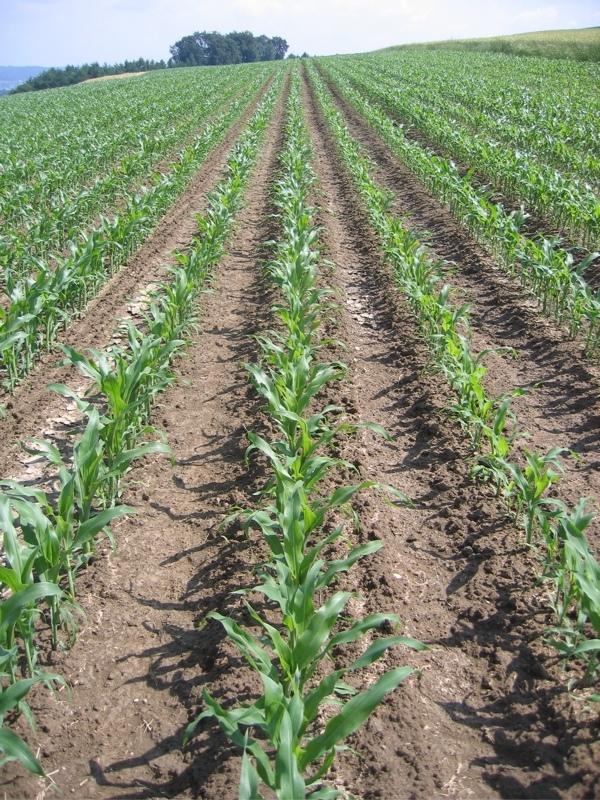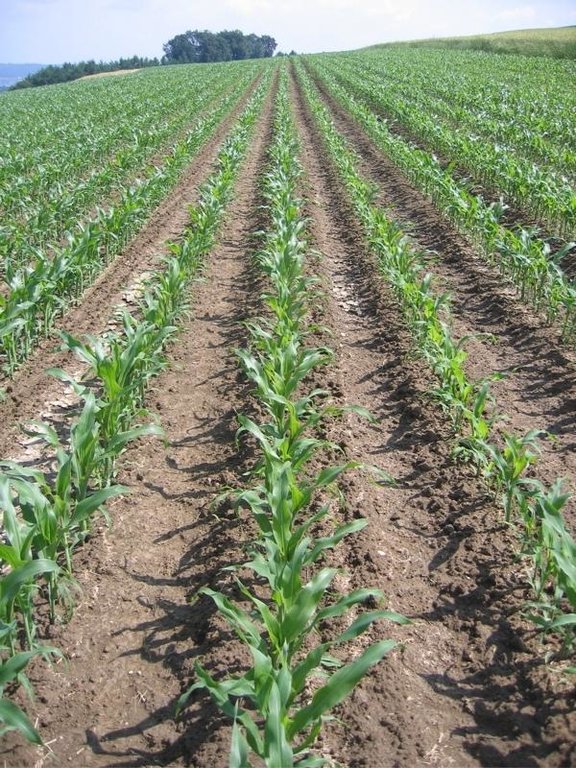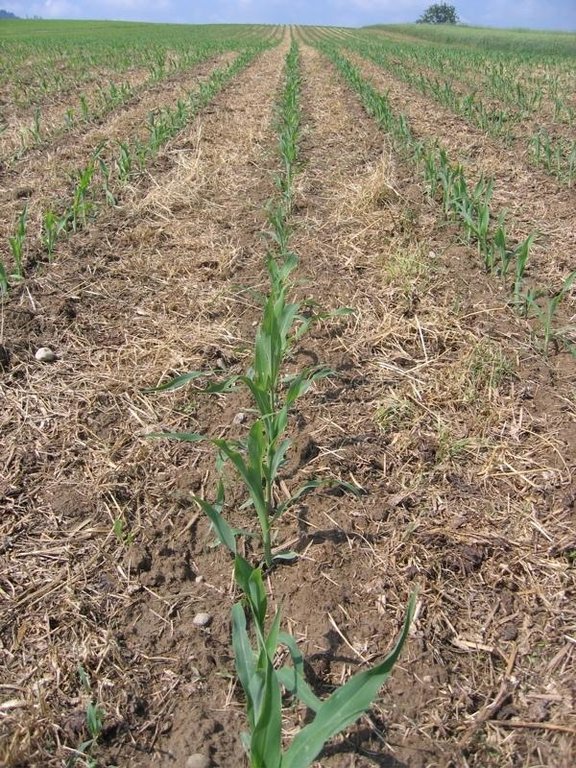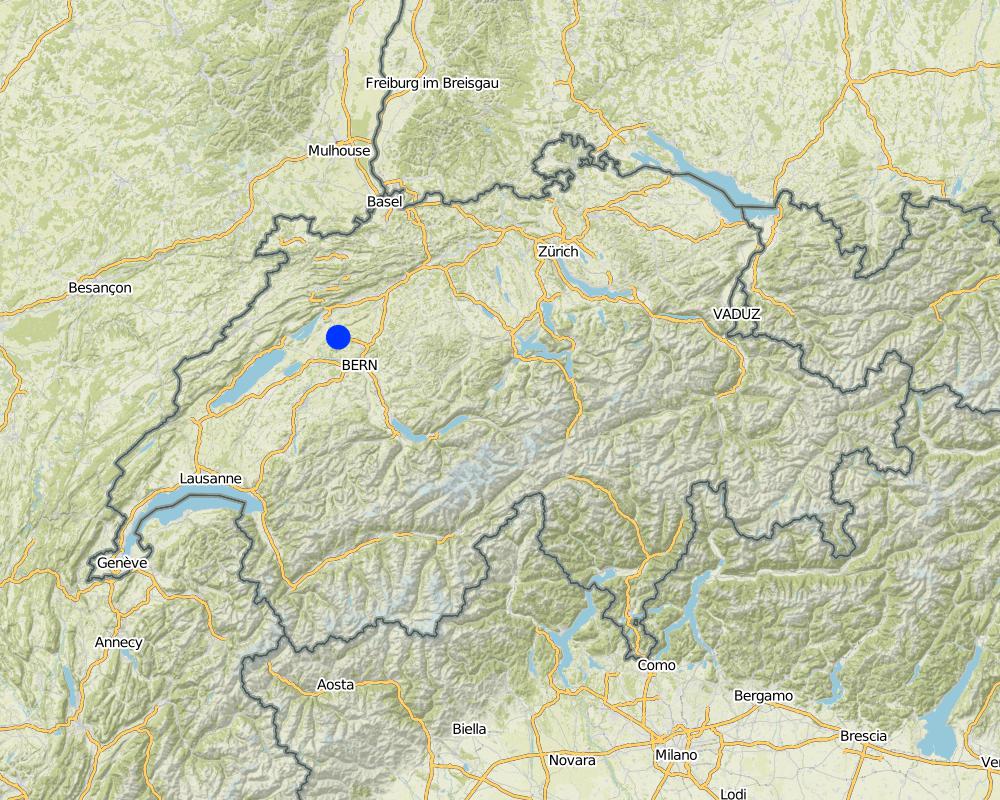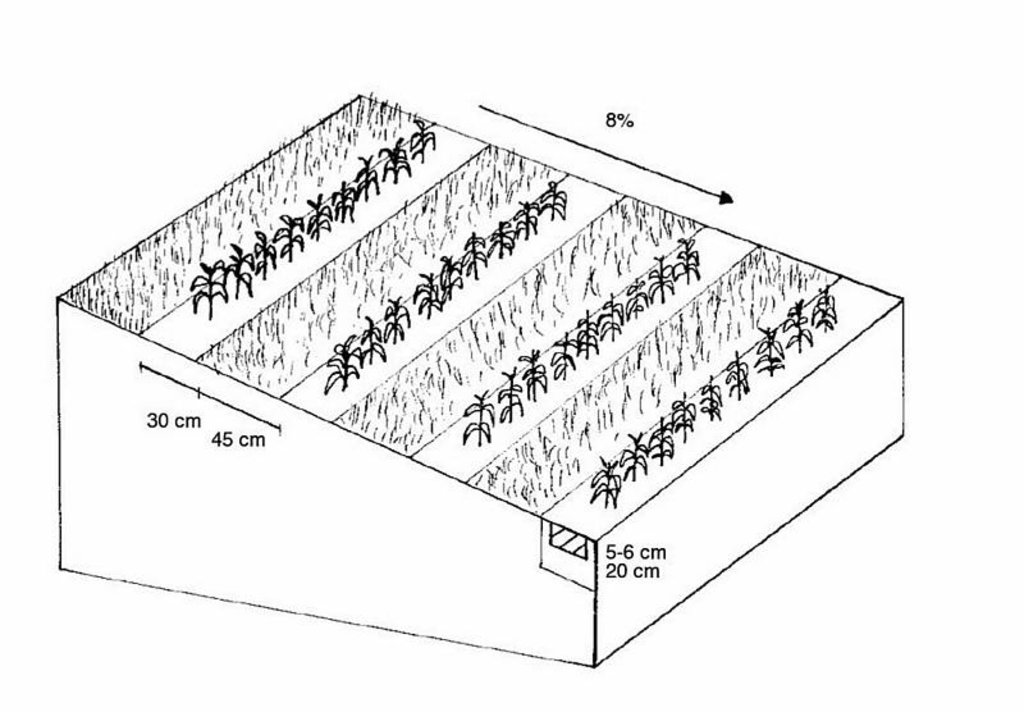Maize strip tillage [瑞士]
- 创建:
- 更新:
- 编制者: Unknown User
- 编辑者: –
- 审查者: Fabian Ottiger, Alexandra Gavilano
Streifenfrässaat
technologies_1008 - 瑞士
查看章节
全部展开 全部收起1. 一般信息
1.2 参与该技术评估和文件编制的资源人员和机构的联系方式
关键资源人
SLM专业人员:
Buddeke Giulietta
Geographisches Institut der Universität Bern -GIUB
瑞士
土地使用者:
Friederich Jürg
Landwirtschaftliches Lohnunternehmen Seelandzenturm Suberg
瑞士
有助于对技术进行记录/评估的机构名称(如相关)
Jürg Friederich Lohnunternehmung - 瑞士有助于对技术进行记录/评估的机构名称(如相关)
University of Bern, Institute of Geography (GIUB) - 瑞士1.3 关于使用通过WOCAT记录的数据的条件
编制者和关键资源人员接受有关使用通过WOCAT记录数据的条件。:
是
2. SLM技术的说明
2.1 技术简介
技术定义:
Maize strip tillage is used for corn cultivation and the technology ensures that only those stripes are cultivated where seed is applied.
2.2 技术的详细说明
说明:
Maize strip tillageis a soil conservation method used in crop production. First of all the grass in the area needs to be prepared by splattering round-up some 3-10 days in advance. Then the actual maize strip tillage machine carves a stripe and the seed are inserted within this 30 cm strip. At the same time fertilizer is added on these cultivated stripes. Between those cultivated stripes the mulch-grass stripes (45cm) are unmechanised and protect the soil by increasing its stability. Due to these mulch-stripes the matrix of the soil is more complex and therefore the stability is better especially during the harvest in September. The interviewed farmer said it was cause of the improved soil structure that his tractors are not subside and compaction is also less likely to occur. Another advantage is the decreased risk of soil erosion when having more and heavy precipitation, as it is expected for next decades due to climate changes in Switzerland. Thanks to the SLM technology, water infiltration increases and organic matter as well which adds up to a promising growth period.
There are also clear economic advantages, by adopting the technology. In springtime only one working step is needed for seeding compared to the five steps needed with the traditional technique using a plough. Therefore the costs are finally lower with this technology and farmers can use the opportunity when having free labour to work part-time outside the farm. At first sight, the costs might seem higher when adopting this technology cause the farmer needs to hire a subtractor, in the end the costs are lower due to the lower labour input and the lower equipment costs. After having seen the advantages, the interviewed farmer said that the technology is usually maintained.
A high level of knowledge about the natural condition is needed when adopting this technology. On the one hand, the farmer must time the date for seeding adequately to the natural conditions, it needs some 4 days with no precipitation. Then on the other hand, the farmer has to apply Glyphosphat after the seeding in order to guarantee an optimal growth period for the corn. The timing to start seeding with this technology may be later cause corn is sensitive towards rival plants, low temperatures and humidity. These are some of the limits that the technology implies. If springtime is humid, the farmer should be allowed to use the traditional technique, regardless of the subsidies as indicated by the interviewed farmer. The canton of Bern is providing subsidies if the farmer commits to use a five year cycle which inherits not to use the plough during this period but using a mulch system. The interviewed farmer suggests that the canton of Bern could commit itself not only in giving subsidies to the areas but also to support if contractors like him would get subsidies for the investment for machines that are needed. For a single farmer the establishment costs for the equipment are too high so that the average is hiring a contractor who could work for a lower salary when having support to buy machines, so subsidies from the Cantons would be an asset.
2.3 技术照片
2.5 已应用该技术的、本评估所涵盖的国家/地区/地点
国家:
瑞士
区域/州/省:
Bern
有关地点的进一步说明:
Suberg
具体说明该技术的分布:
- 均匀地分布在一个区域
如果不知道精确的区域,请注明大致覆盖的区域:
- 0.1-1 平方千米
Map
×2.6 实施日期
如果不知道确切的年份,请说明大概的日期:
- 不到10年前(最近)
2.7 技术介绍
详细说明该技术是如何引入的:
- 在实验/研究期间
注释(项目类型等):
Peter Hofer made different experiments wiht SLM Technologies and after successful implementation of maize strip tillage, idea was adopted
3. SLM技术的分类
3.2 应用该技术的当前土地利用类型

农田
- 一年一作
年作 - 具体指明作物:
- 谷物类 - 玉米
每年的生长季节数:
- 1
具体说明:
Longest growing period in days: 150Longest growing period from month to month: Apr - Sep
注释:
Major land use problems (compiler’s opinion): Soil erosion in hilly areas
Major land use problems (land users’ perception): Due to changed weather conditions, basically an increase of percipitation, soil erosion increased
Future (final) land use (after implementation of SLM Technology): Cropland: Ca: Annual cropping
3.5 该技术所属的SLM组
- 最小的土壤扰动
- 横坡措施
3.6 包含该技术的可持续土地管理措施

农艺措施
- A1:植被和土壤覆盖层
注释:
Main measures: agronomic measures
Type of agronomic measures: cover cropping, retaining more vegetation cover, mulching, manure / compost / residues, rotations / fallows, minimum tillage
3.7 该技术强调的主要土地退化类型

土壤水蚀
- Wt:表土流失/地表侵蚀
- Wg:冲沟侵蚀/沟蚀

物理性土壤退化
- Pc:压实

生物性退化
- Bc:植被覆盖的减少
注释:
Main type of degradation addressed: Wt: loss of topsoil / surface erosion
Secondary types of degradation addressed: Wg: gully erosion / gullying, Pc: compaction, Bc: reduction of vegetation cover
Main causes of degradation: crop management (annual, perennial, tree/shrub) (using a plough in hilly area increases soil erosion)
3.8 防止、减少或恢复土地退化
具体数量名该技术与土地退化有关的目标:
- 防止土地退化
- 减少土地退化
注释:
Main goals: mitigation / reduction of land degradation
Secondary goals: prevention of land degradation
4. 技术规范、实施活动、投入和成本
4.1 该技术的技术图纸
技术规范(与技术图纸相关):
Technical knowledge required for field staff / advisors: high
Technical knowledge required for land users: moderate
Main technical functions: improvement of ground cover
Secondary technical functions: improvement of topsoil structure (compaction), increase in organic matter, increase of infiltration
4.2 有关投入和成本计算的一般信息
其它/国家货币(具体说明):
Swiss Franc
如相关,注明美元与当地货币的汇率(例如1美元=79.9巴西雷亚尔):1美元=:
1.08
注明雇用劳工的每日平均工资成本:
194.00
4.3 技术建立活动
| 活动 | 时间(季度) | |
|---|---|---|
| 1. | Buy a machine for technology |
注释:
Number of parties sharing: 2
4.4 技术建立所需要的费用和投入
| 对投入进行具体说明 | 单位 | 数量 | 单位成本 | 每项投入的总成本 | 土地使用者承担的成本% | |
|---|---|---|---|---|---|---|
| 劳动力 | applying round-up | ha | 1.0 | 97.0 | 97.0 | 100.0 |
| 劳动力 | maize strip tillage | ha | 1.0 | 388.0 | 388.0 | 100.0 |
| 设备 | Tools | ha | 1.0 | 56300.0 | 56300.0 | 100.0 |
| 技术建立所需总成本 | 56785.0 | |||||
| 技术建立总成本,美元 | 52578.7 | |||||
注释:
Duration of establishment phase: 2 month(s)
4.5 维护/经常性活动
| 活动 | 时间/频率 | |
|---|---|---|
| 1. | Applying round up on the field | 1 |
| 2. | Applying maize strip tillage | 1 |
| 3. | Add herbicide on field | 1 |
| 4. | Harvest of the corn | 1 |
4.6 维护/经常性活动所需要的费用和投入(每年)
注释:
Establishment costs are estimated for the contractor on the one hand and labour costs indicated above are the ones that the contractor is demanding for if he is hired. Additionally, those farmers who adapt this technology can get subsidies from the Canton if he/she commits to apply soil conservating measurements during 5 years, in Bern it is 450 CHF per ha.
4.7 影响成本的最重要因素
描述影响成本的最决定性因素:
Labour costs and costs for diesel are much higher for the traditional technology (plough). The investment for the technology are high in the first term and the labour costs indicated above are given by the contractor if he is hired. So for a regular farmer only these 388 USD are relevant.
5. 自然和人文环境
5.1 气候
年降雨量
- < 250毫米
- 251-500毫米
- 501-750毫米
- 751-1,000毫米
- 1,001-1,500毫米
- 1,501-2,000毫米
- 2,001-3,000毫米
- 3,001-4,000毫米
- > 4,000毫米
有关降雨的规范/注释:
Tendency towards increased rainfall
农业气候带
- 半湿润
Thermal climate class: temperate
5.2 地形
平均坡度:
- 水平(0-2%)
- 缓降(3-5%)
- 平缓(6-10%)
- 滚坡(11-15%)
- 崎岖(16-30%)
- 陡峭(31-60%)
- 非常陡峭(>60%)
地形:
- 高原/平原
- 山脊
- 山坡
- 山地斜坡
- 麓坡
- 谷底
垂直分布带:
- 0-100 m a.s.l.
- 101-500 m a.s.l.
- 501-1,000 m a.s.l.
- 1,001-1,500 m a.s.l.
- 1,501-2,000 m a.s.l.
- 2,001-2,500 m a.s.l.
- 2,501-3,000 m a.s.l.
- 3,001-4,000 m a.s.l.
- > 4,000 m a.s.l.
关于地形的注释和进一步规范:
Altitudinal zone: 101-1000 m a.s.l. (depending on the area)
5.3 土壤
平均土层深度:
- 非常浅(0-20厘米)
- 浅(21-50厘米)
- 中等深度(51-80厘米)
- 深(81-120厘米)
- 非常深(> 120厘米)
土壤质地(表土):
- 中粒(壤土、粉土)
表土有机质:
- 中(1-3%)
如有可能,附上完整的土壤描述或具体说明可用的信息,例如土壤类型、土壤酸碱度、阳离子交换能力、氮、盐度等。:
Soil fertility is medium
Soil drainage/infiltration is good
Soil water storage capacity is medium
5.4 水资源可用性和质量
地下水位表:
5-50米
水质(未处理):
良好饮用水
关于水质和水量的注释和进一步规范:
Availability of surface water: good, medium ( depending on the area )
Water quality (untreated): Good drinking water ( generally good quality of water )
5.5 生物多样性
物种多样性:
- 中等
关于生物多样性的注释和进一步规范:
depending on the area
5.6 应用该技术的土地使用者的特征
非农收入:
- 收入的10-50%
相对财富水平:
- 丰富
个人或集体:
- 个人/家庭
说明土地使用者的其他有关特征:
Difference in the involvement of women and men: Generally speaking, men tend to work on the fields therefore are mainly responsible for technologies, women tend to work in the houshold and are responsible for administrative tasks. In Switzerland there is a traditional labour division between men and women, there might be exceptions but if addressing new technology one has to deal with male farmers. Assuming that decisions to adapt new technologies or for investments are made by both.
Population density: 10-50 persons/km2
Annual population growth: < 0.5%
Off-farm income specification: For those farmers working off-farm it is likely to delegate work to contractor. On the other hand when hiring a contractor there is less labour needed for the farmer and the possibility to work off-farm slightly higher.
5.8 土地所有权、土地使用权和水使用权
土地所有权:
- 个人,未命名
土地使用权:
- 社区(有组织)
用水权:
- 社区(有组织)
注释:
Half of the land is leased and the other was bought by the farmer. He said there is a tendency towards land selling.
5.9 进入服务和基础设施的通道
健康:
- 贫瘠
- 适度的
- 好
教育:
- 贫瘠
- 适度的
- 好
技术援助:
- 贫瘠
- 适度的
- 好
就业(例如非农):
- 贫瘠
- 适度的
- 好
市场:
- 贫瘠
- 适度的
- 好
能源:
- 贫瘠
- 适度的
- 好
道路和交通:
- 贫瘠
- 适度的
- 好
饮用水和卫生设施:
- 贫瘠
- 适度的
- 好
金融服务:
- 贫瘠
- 适度的
- 好
6. 影响和结论性说明
6.1 该技术的现场影响
社会经济效应
生产
生产故障风险
注释/具体说明:
Conditions need to be good, if season too wet, harvest can decrease
收入和成本
农业投入费用
工作量
其它社会经济效应
Use of pesticides
注释/具体说明:
Consequences of using pesticide are not known yet, traces in drinking water might be likely to occure
社会文化影响
SLM/土地退化知识
冲突缓解
生态影响
水循环/径流
地表径流
土壤
土壤流失
土壤有机物/地下C
生物多样性:植被、动物
外来入侵物种
注释/具体说明:
More crows are on the fields after seeding
害虫/疾病控制
其它生态影响
Infiltration
6.3 技术对渐变气候以及与气候相关的极端情况/灾害的暴露和敏感性(土地使用者认为的极端情况/灾害)
渐变气候
渐变气候
| 季节 | 增加或减少 | 该技术是如何应对的? | |
|---|---|---|---|
| 年温度 | 增加 | 好 |
气候有关的极端情况(灾害)
气象灾害
| 该技术是如何应对的? | |
|---|---|
| 局地暴雨 | 好 |
| 局地风暴 | 未知 |
气候灾害
| 该技术是如何应对的? | |
|---|---|
| 干旱 | 好 |
水文灾害
| 该技术是如何应对的? | |
|---|---|
| 比较和缓的(河道)洪水 | 未知 |
其他气候相关的后果
其他气候相关的后果
| 该技术是如何应对的? | |
|---|---|
| 缩短生长期 | 不好 |
注释:
With the grass stripes between the corn rows, the water can infiltrate faster and the soil is more stable and protected. The technology can be more tolerant towards intensive rainfalls but only to a certain extent. The technology is more sensitive when having humid conditions in spring and problems can occure then when trying to apply the stripe mill cropping..
6.4 成本效益分析
技术收益与技术建立成本相比如何(从土地使用者的角度看)?
短期回报:
消极
长期回报:
积极
技术收益与技术维护成本/经常性成本相比如何(从土地使用者的角度看)?
短期回报:
稍微积极
长期回报:
积极
6.5 技术采用
注释:
35% of land user families have adopted the Technology with external material support
Comments on acceptance with external material support: When having good experiences with technology, some 80-90% of the farmers are maintaining this technology
6.7 该技术的优点/长处/机会
| 土地使用者眼中的长处/优势/机会 |
|---|
|
less workload How can they be sustained / enhanced? Farmers should estimate their own labour time as well and then compare the costs of traditional technology and the SLM technology |
|
less costs How can they be sustained / enhanced? In the long-term costs for a farmer decrease by a third. Less diesel costs are needed. |
|
less erosion How can they be sustained / enhanced? Subsidies of the cantons could ensure that farmers adapt technology, therefore enhance their knowledge about soil erosion and the costs. |
| 编制者或其他关键资源人员认为的长处/优势/机会 |
|---|
|
reduction of soil erosion How can they be sustained / enhanced? Enhancing knowledge about soil erosion |
|
improvement of soil structure How can they be sustained / enhanced? Enhancing knowledge by experiments shown to farmers |
6.8 技术的弱点/缺点/风险及其克服方法
| 土地使用者认为的弱点/缺点/风险 | 如何克服它们? |
|---|---|
| Timing is needed | Enhance knowledge about technology when conditions are too wet, farmers should be allowed to use plough instead of SLM technology |
| Subsidies only for areas | Canton could subsidies/support if contractor or farmer invests in a machine used for strip mill cropping. 5 years of subsidies might be too short |
| 编制者或其他关键资源人员认为的弱点/缺点/风险 | 如何克服它们? |
|---|---|
| use of pesticide | It is not estimated yet whether the use of pesticide has traces in the drinking water |
7. 参考和链接
7.1 信息的方法/来源
链接和模块
全部展开 全部收起链接
无链接
模块
无模块


